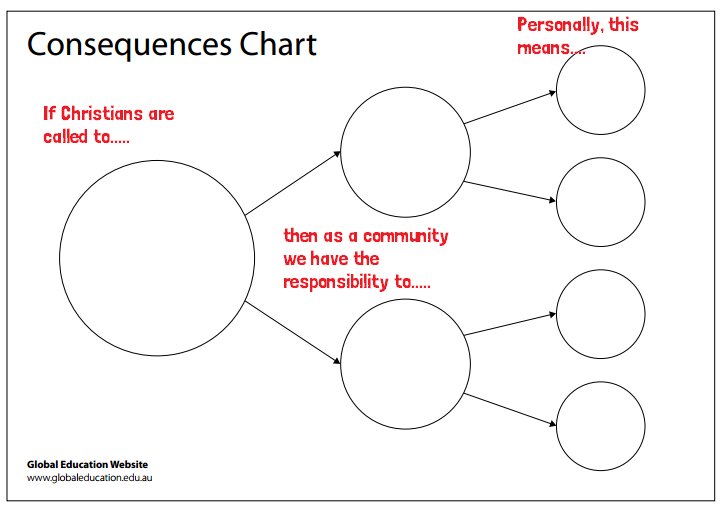Teacher introduction
By the end of this unit, students will have explored their current personal understandings of justice; investigated Church teachings on caring for the poor; related Scripture to their own experiences of love and compassion to consider ways they can live and act with a concern for the poor; and explored how we are all connected in the quest for justice for the poor.
A note on talking about “the poor”: At Caritas Australia, we aim to communicate in an inspiring and respectful tone. Much of the messaging that exists about international aid and development encourages us to see ‘poor people’ as different to us, rather than recognising that it’s the unjust circumstances that people are in that are different. We want to steer away from perpetuating the construct of ‘them and us’ and it into a construct of ‘we’. Even though we are talking about people in difficult situations, it is important to emphasise human dignity and people’s strengths, their resilience and perseverance. It is more challenging to communicate such nuances to a younger audience, so at this level, we suggest starting to use language such as ‘‘people experiencing poverty’ rather than ‘the poor’, so as not to reduce people to the conditions they may be experiencing at the time.
Teachers, before you start:
- Watch the CST ‘Preferential Option for the Poor’ film for your own background and familiarise yourself with the Upper Primary cartoon (found within the Learning Experience below).
- Download the various resources referenced (worksheets, slides, etc.) and have them ready to go on your computer/interactive whiteboard.
- Locate the Scriptures and copies of Church texts (all hyperlinked within the Learning Experience below).
- Familiarise yourself with and decide on the use of online or app technologies.

Learn - Focus
Explore current personal understandings of justice.
Display the Preferential Option for the Poor Editorial cartoon poster.
Use the thinking routine ‘See- Think- Wonder’ to discuss.
Some questions to initiate or further the discussion could include: What does the cake represent? What are the world’s resources? What are the people in the cartoon expressing? What makes you say that?
Tune into students understandings of justice using the Text Connections Tool: 3T’S
Write examples where an injustice or a situation of unfair sharing has occurred or is represented.
Text to self:: A relevant personal example.
Text to Text:A text, movie, song, book that contains similar themes.
Text to World: An example of in society. This could be written in a reflection book, or completed electronically on an app such as TYPO3's
You can set a time limit on the routine, 1 minute for each connection, or simply do it as a class discussion.
Introduce the broader inquiry: What is justice for the poor?
Collect a list of student generated questions around this concept. These could be displayed each session and added to throughout the sequence.
This could also be completed individually on paper, or using an interactive pinboard app ‘Lino’

Learn - Explore
Students investigate Church text teachings on caring for people experiencing poverty.
Select one of the excerpts from Populorum Progressio-On the development of people document provided.
Display the selected excerpt in large text, with space around text for annotation and elaboration. Analyse and discuss the excerpt as a class. Define and annotate any unfamiliar and key words. Read through as a whole passage, and break up into phrases. Discuss, define and visualise concepts in the excerpt.
Have students discuss in pairs what the main message of the excerpt is. Discuss the implications for us as Christians. Paraphrase the main teaching and write beneath the annotated excerpt.
Alternatively other Church texts such as Pope John Paul II (1987) On Social Concern (Religious Life of the School P-12) Vatican II – Pastoral Constitution on the Church in the Modern World could be used, or students could research the words of Pope Francis.

Learn - Demonstrate
Students draw on Scripture and their own experiences of love and compassion to consider ways they can live and act.
Discuss existing understanding of what an organisation like Caritas does to be part of God’s dream for the world.
Read Caritas Australia’s inspiration and mission.
Discuss: What does this statement reveal about Caritas Australia’s role in God’s dream for the world?
Teacher’s Note: Caritas Australia believes caring for people experiencing poverty is everyone’s responsibility. Preferential care should be shown to poor and vulnerable people, whose needs and rights are given special attention in God’s eyes. This is preferential option for the poor.
Jesus taught that God asks each of us what we are doing to help the poor and needy: “Amen, I say to you, whatever you did for one of these least brothers of mine, you did for me” (Matthew 25:40).
How it guides Caritas Australia’s work: Reaching the poorest and most marginalised people often requires greater effort in discovering where they are to be found. This sometimes means additional resources of time and money.
Students Research in groups and present about a Caritas Australia project that promotes and supports the wellbeing of others.
Students present their findings to the class using the proforma provided.
Read Matthew 25:34-36
Discuss: What does Jesus ask us to do for the poor? What is our responsibility?
As a class, choose one action or aspect and make connections by using the Consequence chart strategy See below for a guide:


Act
Explore how we are all connected in the quest for justice for the poor.
Review the Preferential Option for the Poor Editorial cartoon poster.
Discuss: So what is preferential option for the poor? What has been learnt about caring for the poor in the Bible?
Students individually reflect the sentence starters, exploring new learnings or changes in thinking.
‘I used to think….now I think’, ‘One thing I found out was….’
Or the questions:
What is one way that we can support members of our global family living in poverty?
What does our research make us wonder more about?
Students present their reflection visually in a poster, or using an app such as Canva.
As a class or individually, students generate questions they still have about justice for people experiencing poverty.

Pray
Read a classroom or school prayer.
Integrate a concern for people experiencing poverty around the world, into the prayer. Alternatively write a new class prayer concerning people experiencing poverty around the world.
Students could also set themselves a personal challenge ‘How will I live and act out love and compassion?’ and track their progress and reflection in a video journal or blog.
Download
- Caritas research worksheet (DOC, 90KB)
- Populorum Progressio worksheet (PDF, 730KB)
- Upper Primary Poster/ Cartoon (PDF, 3.17MB)
- All Upper Primary 'Preferential option for the poor' resources (ZIP, 5.24MB)
- CST Prayer (PPT, 4.8MB)